Friday, December 12, 2014
As we were ready to leave at 7:30AM we received word that fuel was difficult to find today. Our departure was delayed a bit.
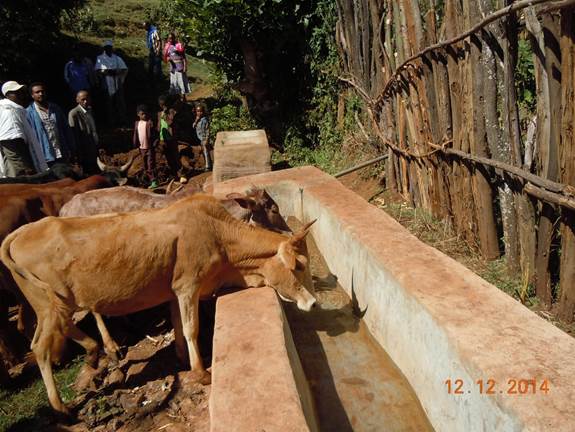
The people water collection is to the right behind the fence. Of course one of the reasons we require fences is to keep cattle out and in this case the cattle trough is available. In most of the cases the collection for people is early AM and late PM with the cattle trough filled about noon. Note also the there is a stand up laundry area just beyond the cattle trough.
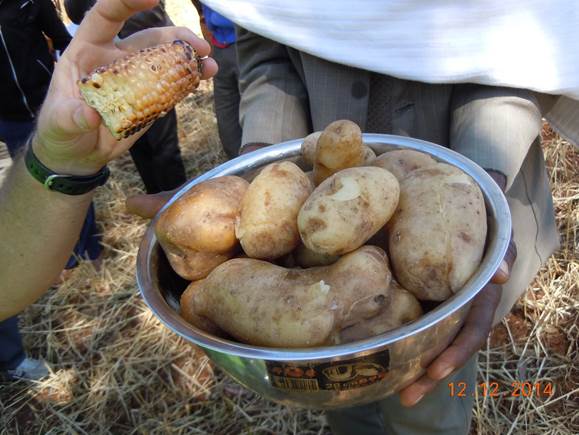
Grateful communities often want to share refreshments and food as a way of expressing appreciation. Today as we were leaving so we could keep our schedule we were given a piece of maize that was warm on their grill of sorts. It is quite tasty and look at these potatoes.
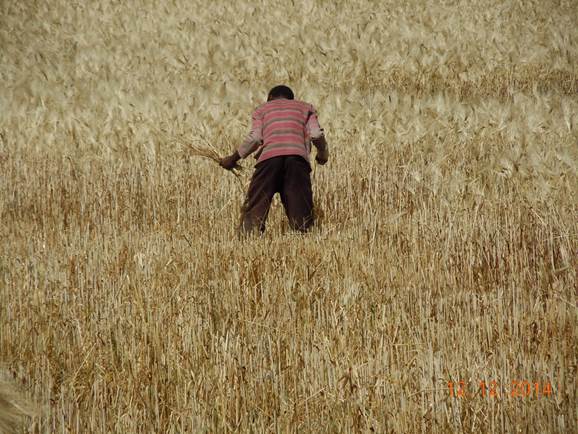
This farmer is cutting his wheat with a small scythe. Note he is only cutting off about the top ½ of the growth. On average a farmer will have about 6 acres and wheat yields that were impressive. All hand tilled, planted and harvested.
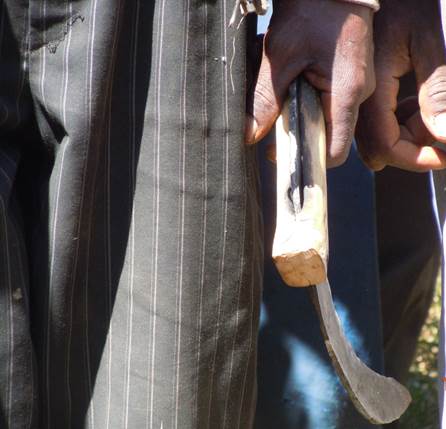
And here is the scythe used to harvest wheat, barley, teff and some other small plants.
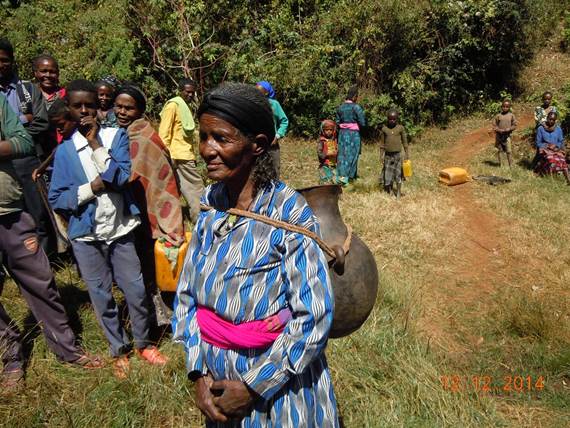
We rarely see a ceramic jug any longer because they are so heavy. Note how the rope cuts across her arms and chest. We have been told that the rope can cause callusing when it rubs. The typical jerry can is in the background. At this site a group met us with song and dance and the drum was the jerry can.
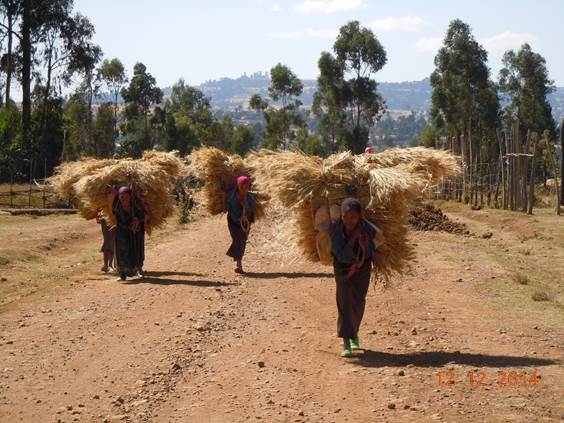
These ladies are carrying the harvested wheat from the field to we presume the compound where they live. The threshing is done on the ground usually with animals walking in a circle causing the seeds to be separated from the stalk. The farmer will then toss the stalk in the air to be sure all has been separated and the seeds are picked up and stored or to market. Part of the example of subsistence farming.
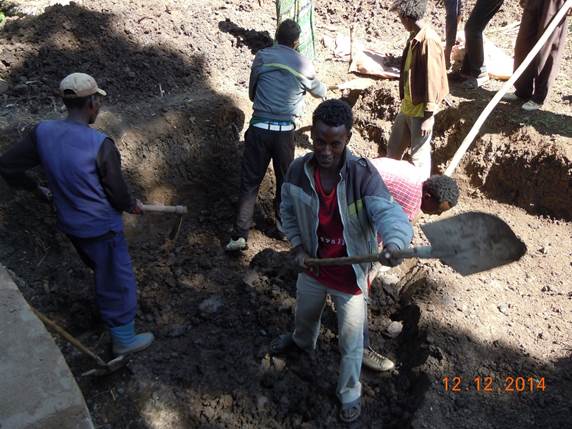
One of our stops today was to visit a spring protection system under construction. There is 41 households in the service area of this site. The workers shown here are volunteering their labor. They have established a savings account. They expect the work to be done in about two weeks. The sand for the cement makes about a two hour trip and must be carried in by hand or on the backs of donkeys about ½ mile. They have learned from others who have disease free water and are pleased they are almost there too. Took some video of this busy bee activity.
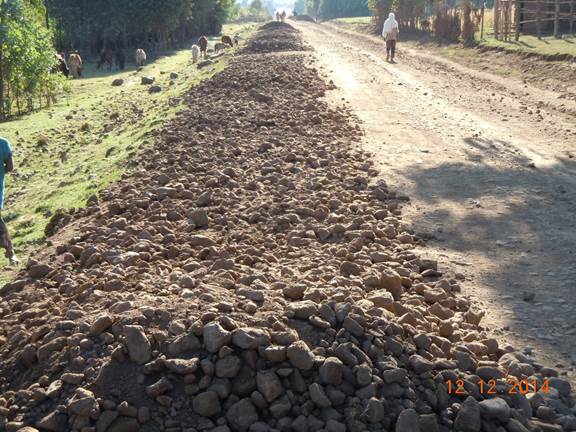
Some of our better gravel roads are under added topping. The size of the gravel does not make for a smooth ride. And many of the roads were not anywhere near this nice. How the vehicle endures is hard to believe. We did have a bit of vehicle problem today and this is when I took this picture. We say at the end of a day is we have had an African massage from riding on rough bumpy roads and off road too.
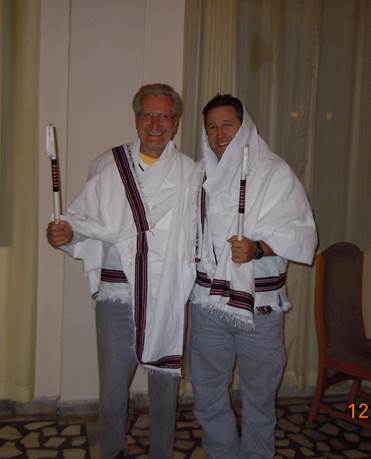
We ended our day with a nice dinner hosted by our host the Central Gibe Synod of Mekane Yesus. The area government water commissioner also attended. He reported that our work in the area in 2014 was wonderful. It is a very rural area and disease free water coverage went from approximately 35% to 78%. The remainder to achieve 100% is for the large village. This is the result of the 20 projects of this year. Much appreciation. What a tribute to our work and so many thanks to generous donors from Water to Thrive. Mike and I were presented with some traditional garb of the area. Now if we aren’t a pair. Tomorrow is a stop at a local orphanage (seeking a well) and travel to Addis Ababa for a meeting in the evening and on Sunday, we fly north Ethiopia for work with our implementing partner there.
-Ed Scharlau
Friday, December 12, 2014
As we were ready to leave at 7:30AM we received word that fuel was difficult to find today. Our departure was delayed a bit.

The people water collection is to the right behind the fence. Of course one of the reasons we require fences is to keep cattle out and in this case the cattle trough is available. In most of the cases the collection for people is early AM and late PM with the cattle trough filled about noon. Note also the there is a stand up laundry area just beyond the cattle trough.

Grateful communities often want to share refreshments and food as a way of expressing appreciation. Today as we were leaving so we could keep our schedule we were given a piece of maize that was warm on their grill of sorts. It is quite tasty and look at these potatoes.

This farmer is cutting his wheat with a small scythe. Note he is only cutting off about the top ½ of the growth. On average a farmer will have about 6 acres and wheat yields that were impressive. All hand tilled, planted and harvested.

And here is the scythe used to harvest wheat, barley, teff and some other small plants.

We rarely see a ceramic jug any longer because they are so heavy. Note how the rope cuts across her arms and chest. We have been told that the rope can cause callusing when it rubs. The typical jerry can is in the background. At this site a group met us with song and dance and the drum was the jerry can.

These ladies are carrying the harvested wheat from the field to we presume the compound where they live. The threshing is done on the ground usually with animals walking in a circle causing the seeds to be separated from the stalk. The farmer will then toss the stalk in the air to be sure all has been separated and the seeds are picked up and stored or to market. Part of the example of subsistence farming.

One of our stops today was to visit a spring protection system under construction. There is 41 households in the service area of this site. The workers shown here are volunteering their labor. They have established a savings account. They expect the work to be done in about two weeks. The sand for the cement makes about a two hour trip and must be carried in by hand or on the backs of donkeys about ½ mile. They have learned from others who have disease free water and are pleased they are almost there too. Took some video of this busy bee activity.

Some of our better gravel roads are under added topping. The size of the gravel does not make for a smooth ride. And many of the roads were not anywhere near this nice. How the vehicle endures is hard to believe. We did have a bit of vehicle problem today and this is when I took this picture. We say at the end of a day is we have had an African massage from riding on rough bumpy roads and off road too.

We ended our day with a nice dinner hosted by our host the Central Gibe Synod of Mekane Yesus. The area government water commissioner also attended. He reported that our work in the area in 2014 was wonderful. It is a very rural area and disease free water coverage went from approximately 35% to 78%. The remainder to achieve 100% is for the large village. This is the result of the 20 projects of this year. Much appreciation. What a tribute to our work and so many thanks to generous donors from Water to Thrive. Mike and I were presented with some traditional garb of the area. Now if we aren’t a pair. Tomorrow is a stop at a local orphanage (seeking a well) and travel to Addis Ababa for a meeting in the evening and on Sunday, we fly north Ethiopia for work with our implementing partner there.
-Ed Scharlau

About The Author: Water to Thrive
More posts by Water to Thrive